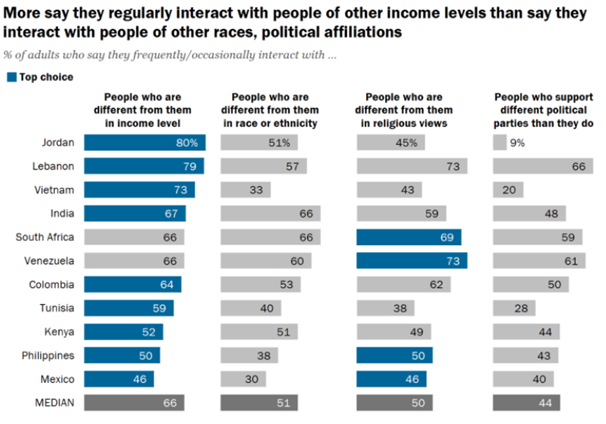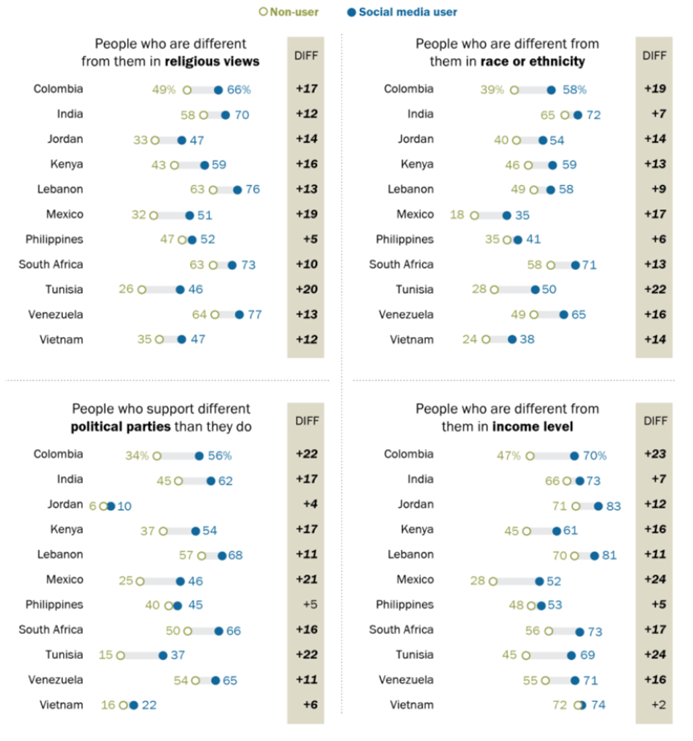Digital community’s assignment exploring the effects of digital communication on social affairs
Question
Task: How can the effect of digital communication on social affairs be examined using Digital community’s assignment research techniques?
Answer
Introduction
The Digital community’s assignmentresearch shows there has been an explosion in mobile technology, an increase in accessible knowledge, and a surge in social media platforms that allow individuals to relate to public life in a variety of ways. More than a billion people use social media every day, blurring the distinction between private and public information and the roles played by both producers and consumers. Additionally, these platforms give opportunities for users to interact with the material they find on them in their social networks, such as by commenting, like, or sharing(Swart, Peters and Broersma, 2018). The "public connection" that social media may provide users with enables them to participate in their daily lives in their cultural, social, civic, and political networks.
Social media apps and platforms in particular, enhance people's public connections inside groups by concentrating on the importance of news and journalism, which are examined in this article. To develop community and social integration, news has always been seen as one of the most important vehicles for creating common frames of reference for public life. Concerns about the effect of social media platforms' ability to link people are being raised.
Digital community’s assignment Discussion
Descartes says “I think therefore I am” and a fragmented form of the self, would be predicted by social psychologist Kenneth Gergen in his 1991 book, The Saturated Self. As per Naeem (2021) whether or if social media has a long-term psychological influence on people and their unique sense of "self" is yet unknown. The Digital community’s assignment research shows Digitized, monitored, and related to metrics have grown to be a norm in our everyday life. On-line personas, such as avatars, profile photographs, and status updates, have become our primary means of communication. Though Facebook, Twitter, and LinkedIn have the potential to unite people across the globe, to foster professional opportunities for their users, and even to help elect presidents of their countries, these social media platforms have also unleashed an array of psychological issues that have altered our collective perception of reality.
The interaction between users, the connection between users, and the user-generated content are what characterise social media. People make use of social media on a constant basis in order to communicate with one another. People use social media for a variety of reasons, the most common of which are to make social connections, get access to information, and make decisions. Through the use of social media, one of the most effective methods to interact with people both locally and all over the world may be attained. Customers' purchase decisions on social media may be influenced by a variety of factors, including reviews, marketing methods, and advertising.
A virtual existence is gleaming and glistening as people submit their greatest photos and share the most exciting news over the social media platforms. As per the Digital community’s assignment findings social networking sites like Facebook, people assume to be presenting a pretentious life, by picturing their profile as someone else, which often the ideal of who the person want to be. In games these people play an avatar, by representing themselves in the most revealing manner living under a delusion (Scolere, Pruchniewska and Duffy, 2018). Social networks are no longer only a convenient method to stay in contact with friends and family; they are now being utilised in ways that have actual ramifications for society overall. Seargeant and Tagg (2019) says many of the world's most important issues are being shaped by the way social media is being utilised.Recent changes in information and communication technology (ICT) have been fast, with social media being a significant development throughout that time period. Changing faster than ever before is the new normal. The reach of social media has been significantly expanded, for instance, as a direct result of the proliferation of mobile technologies. When it comes to the total amount of time spent online, mobile devices are in the lead. With the assistance of this newly developed technology, individuals are now able to connect whenever they want and from any location.
The Digital community’s assignment research shows, the population of people who use the internet makes use of social media platforms to an extent that approaches 80 percent. Everyone who has a viewpoint that is not popular may now realise that he isn't alone thanks to the internet, which made it possible for him to do so. As a consequence of this, the individuals in question may engage in activities such as the production of memes, periodicals, and whole online worlds that serve to bolster their worldviews before breaking through to the mainstream. If it weren't for social media, people wouldn't be aware of the social, ethical, environmental, and political concerns that exist in the world. Because to the widespread dissemination of worries, the distribution of power has shifted away from a select few and toward a larger population.

Fig. 1: Interacting with people of different incomes is common in most countries surveyed
(Source: SILVER and HUANG, 2019)
These social networking sites are increasingly being used for purposes other than just keeping in touch with friends and family. Background checks are becoming more common for job applicants on social networking sites like Facebook and other comparable platforms with growing frequency among recruiters. Even if organisations are unable to come together in person, they may still have virtual meetings or debate topics together online. As a direct consequence of this, school projects and board meetings will have access to more spare time. As a society, we have developed a greater reliance and dependence on various forms of social media.In today's environment, people depend heavily on social media to keep us connected and to communicate with one another. It is more common for social media users in the countries examined to communicate with individuals from a variety of backgrounds than non-users. The Digital community’s assignmentresearch shows these individuals are significantly more likely to interact with people from other socioeconomic backgrounds than they are with people who identify with their own political party, and they are also significantly more likely to interact with people from other races and ethnicities, as well as individuals who hold different religious beliefs than they do.

Fig 2:Social media users more likely to interact with people who are different from them
(Source: SILVER and HUANG, 2019)
In spite of the fact that activism on social media has increased public awareness of societal problems, it is still unclear as to whether or not this increased information is contributing to genuine change. Some people believe that social sharing has encouraged people to voice their concerns about social problems by using computers and mobile phones rather than actively participating in campaigns in real life. When individuals are offered alternatives that free them of responsibility, this is a natural response. People are more inclined to make a significant financial gift when they are given the option to publicly display their support. People who donate privately do it because the cause is aligned with their ideals, not because they want to appease others' expectations (Dragiewicz et al., 2018).
Nowadays, it's difficult to find a company that doesn't have an online presence on at least a few of the most popular social media networks. Consumer engagement and revenue generation through social media are becoming more vital for companies today.Using social media to get insights, build demand, and develop tailored product offers has become common practise for businesses. Traditional brick-and-mortar companies, as well as e-commerce, take this into account. Researches of Yahia, Al-Neama and Kerbache (2018) show that workplace communication might be aided by the use of social media. As a result, Digital community’s assignmentproject management processes are improved, and specialised knowledge may be communicated more effectively.Boundaries and silos can be broken down, communication can improve, and more highly qualified employees may be created with the assistance of social technologies fully implemented in the workplace(Pearce et al., 2018).
Conclusion
Social media offers almost limitless opportunities. A day goes by without someone using or referencing social media. Even though social media has only been around for a very short time, it is believed that many people focus on the positive features of social media, rather than its bad side. The Digital community’s assignmentfindings show that even while change is beneficial and unavoidable, it always comes at a cost. Negative repercussions are much more damaging than good ones in the long term.
References
Dragiewicz, M., Burgess, J., Matamoros-Fernández, A., Salter, M., Suzor, N.P., Woodlock, D. and Harris, B. (2018). Technology facilitated coercive control: domestic violence and the competing roles of digital media platforms. Feminist Media Studies, Digital community’s assignment 18(4), pp.609–625. doi:10.1080/14680777.2018.1447341.
Naeem, M. (2021). Do social media platforms develop consumer panic buying during the fear of Covid-19 pandemic. Journal of Retailing and Consumer Services, [online] 58, p.102226. doi:10.1016/j.jretconser.2020.102226.
Pearce, W., Niederer, S., Özkula, S.M. and Sánchez Querubín, N. (2018). The social media life of climate change: Platforms, publics, and future imaginaries. Wiley Interdisciplinary Reviews: Climate Change, 10(2). doi:10.1002/wcc.569.
Scolere, L., Pruchniewska, U. and Duffy, B.E. (2018). Constructing the Platform-Specific Self-Brand: The Labor of Social Media Promotion. Social Media + Society, 4(3), p.205630511878476. doi:10.1177/2056305118784768.
Seargeant, P. and Tagg, C. (2019). Social media and the future of open debate: A user-oriented approach to Facebook’s filter bubble conundrum. Discourse, Context & Media, Digital community’s assignment [online] 27, pp.41–48. doi:10.1016/j.dcm.2018.03.005.
SILVER, L. and HUANG, C. (2019). 2. Social media users more likely to interact with people who are different from them. [online] Pew Research Center: Internet, Science & Tech. Available at: https://www.pewresearch.org/internet/2019/08/22/social-media-users-more-likely-to-interact-with-people-who-are-different-from-them/ [Accessed 17 Jun. 2022].
Swart, J., Peters, C. and Broersma, M. (2018). Shedding light on the dark social: The connective role of news and journalism in social media communities. New Media & Society, 20(11), pp.4329–4345. doi:10.1177/1461444818772063.
Yahia, I.B., Al-Neama, N. and Kerbache, L. (2018). Investigating the drivers for social commerce in social media platforms: Importance of trust, social support and the platform perceived usage. Journal of Retailing and Consumer Services, Digital community’s assignment 41, pp.11–19. doi:10.1016/j.jretconser.2017.10.021.












